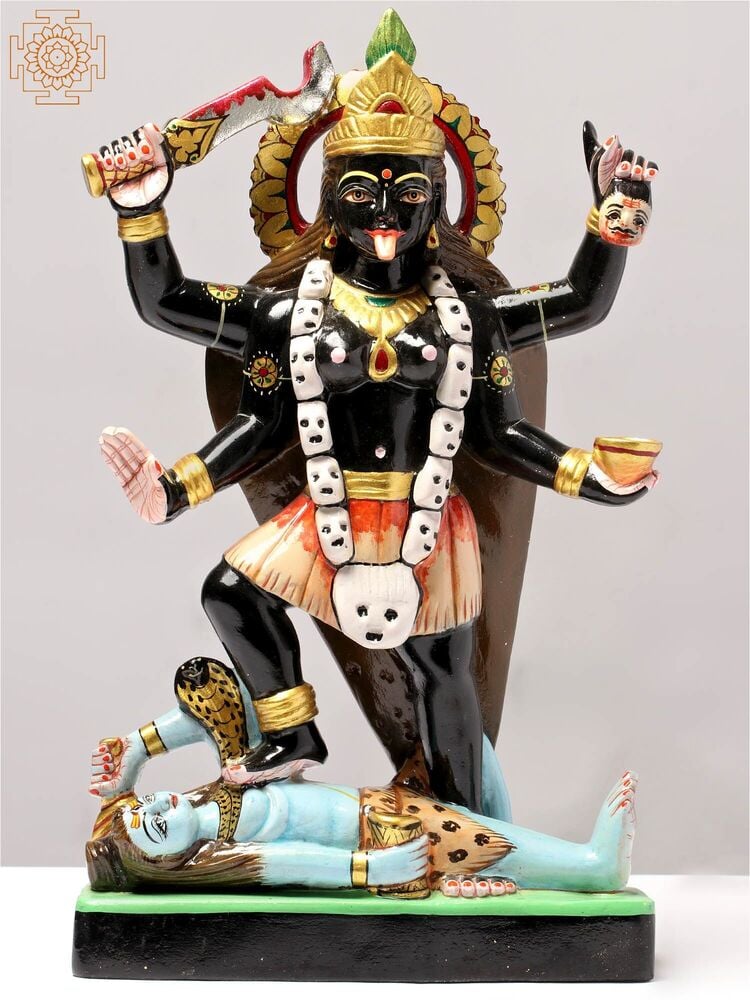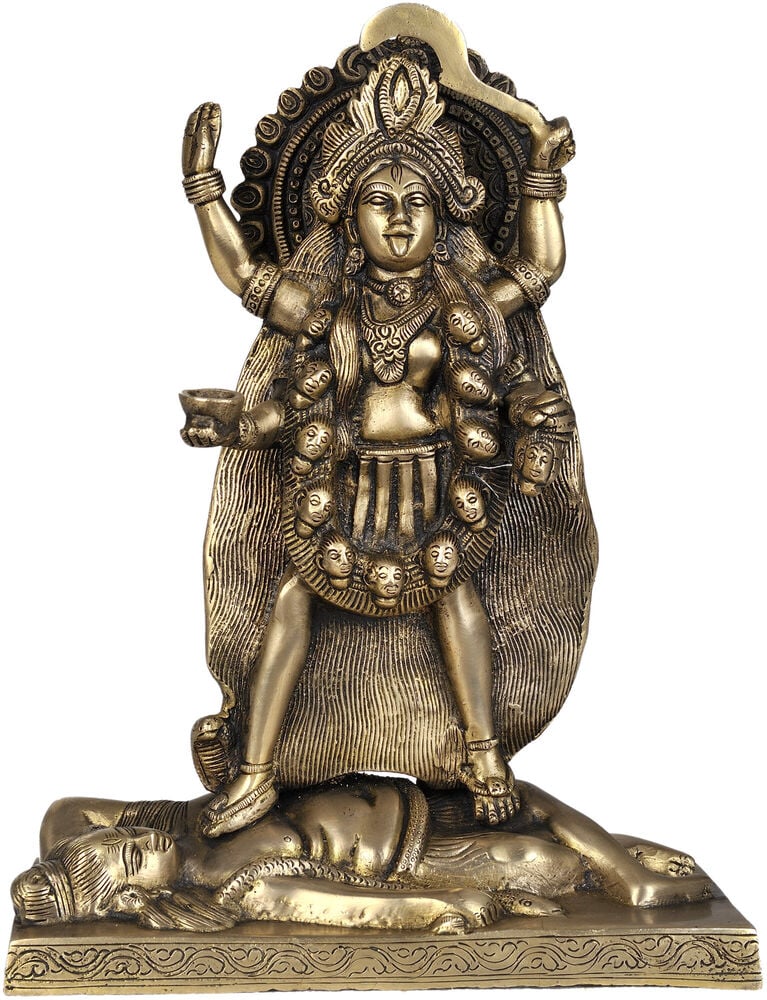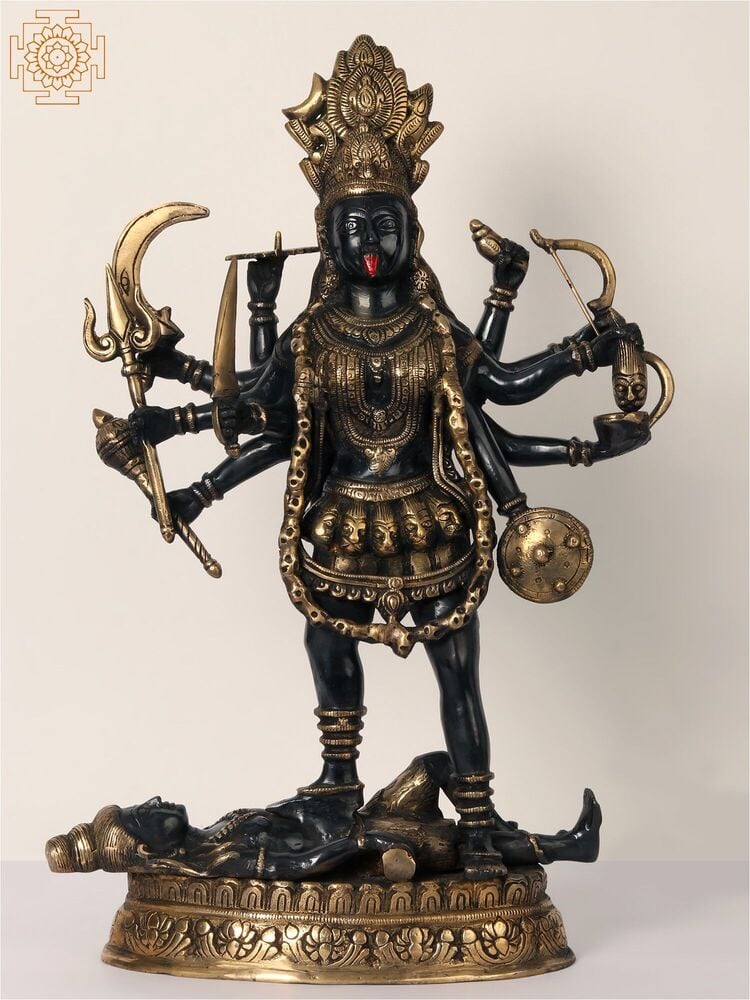See It In Your Home
The ferocious Mahakali, as black as the blackest night. But for the scarlet gleam of Her bloodthirsty mouth, the iconography of Her that you see on this page is a statement monotone composition.
With Her multitudinous heads and limbs, She proceeds to step right upon the great breast of Lord Shiva, Her husband. This utter submission in the stance of Shiva accentuates the independent omnipotence of Kali.
Every feature of Her numerous faces, the curve of every limb She is possessed of, has been carved with remarkable detail. Despite the anatomical oddities of Her appearance, Her body emanates with a lifelike quality, which is in turn superseded by an unputdownable harmony. A girdle of severed arms of devotees clothes Her loins; a garland of the heads of slayed adharmess barely covers the feminine curves of Her torso. Each such detail has been attended to with the greatest care and skill by the artisan.
Despite the wrathful language of Her form, the face of Kali bears an equanimous expression. Those features, like the shapely hands and feet, are delicately sculpted and betray the vulnerability inherent in the beauty of the feminine. As such, She is no less of a devi than Her serene counterparts; and, in fact, may be their superior in terms of divine prowess.
Embracing the Divine Feminine: Understanding Kali and Her
Significance
Goddess Kali is one of the most powerful and revered deities in
Hinduism and is worshiped by many people across the globe
especially in the eastern part of India. She is considered to be
a ferocious form of Goddess Durga and is regarded as the
ultimate manifestation of Shakti. Goddess Kali also manifests as
the material nature and is regarded as the mother of all living
entities in the material world. Just like a caring mother, she
protects the living entities who follow the principles of Dharma
from demonic persons who always go against the laws of the
Supreme Lord.
Having a dark complexion, open hair, and bearing multiple arms
holding different weapons, Goddess Kali is often depicted
standing on the chest of Lord Shiva, her consort, as she
displays her rage toward the demon Raktabij. This pastime is
mentioned in various Puranas of Vedic literature in which
Goddess Kali severed the head of the demon who was creating
havoc on earth. This shows the protective nature of the Goddess.
The Vedic scriptures also mention that Goddess Kali is an
obedient devotee of the Supreme Lord Krishna or Vishnu who tests
living entities on their determination and devotion toward the
Lord.

What does Kali symbolize?
Goddess Kali is the manifestation of material nature. She is
like a benevolent mother who protects her children from any kind
of mishaps and misfortune. Mother Kali considers all living
entities her own children and takes care of them. She reforms
the forgetful souls who have turned their faces against the
Supreme Lord Krishna. Thus, she symbolizes mercy, compassion,
and kindness. Although she has a ferocious form, she is actually
carrying out the order of the Supreme Lord by utilizing her
power against those who blaspheme the Lord and do not abide by
His laws.

What is Kali worshiped for?
We can find thousands and lakhs of devotees of Goddess Kali all
over the world. She is especially venerated in the festival of
Kali Puja in the Indian states of West Bengal, Assam, and
Odisha. Being a merciful Goddess, she fulfills the desires of
her devotees. Some people worship Goddess Kali for some material
gains and profits and receive her blessings. However, those who
serve her selflessly and approach her to know about the Absolute
Truth and the real aim of human life, receive the highest
benediction of Goddess Kali. Being a devotee of the Supreme Lord
Krishna, she bestows her blessings upon them and guides them to
the path of devotion toward the Lord.

Where to place Kali statue at home?
Keeping the deity of Goddess Kali at home is very auspicious. If
you worship her regularly with faith and devotion, she will
become pleased and will shower her blessings upon you. Knowing
that she is worthy of our respectful obeisance is important and
therefore, you should not keep or handle her deity with a casual
attitude. You must keep the deity on your home altar.
How to keep a Brass statue well-maintained?
Brass statues are known and appreciated for their exquisite beauty and luster. The brilliant bright gold appearance of Brass makes it appropriate for casting aesthetic statues and sculptures. Brass is a metal alloy composed mainly of copper and zinc. This chemical composition makes brass a highly durable and corrosion-resistant material. Due to these properties, Brass statues and sculptures can be kept both indoors as well as outdoors. They also last for many decades without losing all their natural shine.
Brass statues can withstand even harsh weather conditions very well due to their corrosion-resistance properties. However, maintaining the luster and natural beauty of brass statues is essential if you want to prolong their life and appearance.
- The best and simplest way to maintain a brass statue is to clean it at least twice a week using a soft cloth or cotton rag. This will prevent dust from accumulating on the surface. Dusting is especially important for outdoor statues since it is prone to dust accumulation much more than indoors.
- To give a natural shine and luster to the statue, you may apply coconut or olive oil using cotton on every portion. You can use a toothbrush to get to the small crevices but do not be too harsh. This will make the brass statue appear fresh and new with a polished look.
In case you have a colored brass statue, you may apply mustard oil using a soft brush or clean cloth on the brass portion while for the colored portion of the statue, you may use coconut oil with a cotton cloth.
Brass idols of Hindu Gods and Goddesses are especially known for their intricate and detailed work of art. Nepalese sculptures are famous for small brass idols portraying Buddhist deities. These sculptures are beautified with gold gilding and inlay of precious or semi-precious stones. Religious brass statues can be kept at home altars. You can keep a decorative brass statue in your garden or roof to embellish the area and fill it with divinity.
















